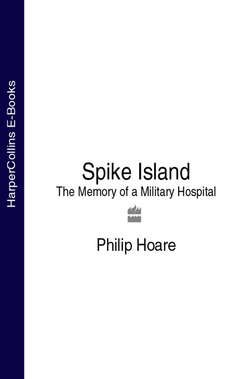Spike Island: The Memory of a Military Hospital

Реклама. ООО «ЛитРес», ИНН: 7719571260.
Оглавление
Philip Hoare. Spike Island: The Memory of a Military Hospital
Copyright
Map
Dedication
Contents
Prologue
Spike Island
In a Lonely Place
Southern Gothick
Pray Stop All Work
In the Very Best Style
A Remarkable Improvement
Enter His Gates with Thanksgiving
Remembrance Day
D Block
Towards a Better Britain
His Dark Estate
The World is Infinitely Forgiving
Epilogue
Afterword
If you enjoyed Spike Island, check out these other great Philip Hoare titles
Notes
Index
Footnotes
Acknowledgements
About the Publisher
Отрывок из книги
Philip Hoare was born in Southampton and brought up next to Netley’s military hospital. He is the author of Serious Pleasures: The Life of Stephen Tennant (1990); Noel Coward: A Biography (1995); and Wilde’s Last Stand: Decadence, Conspiracy & the First World War (1997). His film on Hampshire for BBC2’s Travels with Pevsner was broadcast in 1998, and in 1999 he co-curated the Icons of Pop exhibition at the National Portrait Gallery. He lives in London.
‘A book that has everything a passionate reader could want – a subject that far transcends the trivial pursuits of contemporary writing, concerns both public and private, astonishing details, stylistic precision, a unique sense of time and place, and a great depth of vision.’
.....
Displayed on the London stage in replica, Netley’s ruins had become a gothic commodity. In 1795 the Reverend Richard Warner wrote his Netley Abbey, a Gothic Story in Two Volumes, another opportunist conflation, printed by the Minerva Press (‘the most famous house of sensational fiction’, publishers of Ann Radcliffe’s gothic novels). Warner’s morality tale – translated into both German and French editions – conflates Netley’s myths in its medieval hero, Edward de Villars, who rescues an imprisoned nineteen-year-old girl, the beautiful, auburn-haired Agnes, from a cell in the abbey in which she was confined by the wicked Abbot Peter, in the pay of the yet more evil Sir Hildebrand Warren who has already murdered her father, and whose ghost comes back to haunt him. In the final scene both the Abbot and Sir Hildebrand meet a bloody end, allowing Agnes to be reunited with her brother and the author to draw his moral conclusion on ‘persecuted virtue’.
As well as inspiring such sensational literature, Netley also prompted a healthy trade in cheap prints. Tourists could have the romantic ruins as seen through its woods, thrillingly overgrown, or from the shore, jauntily contrasted with the modern traffic of Southampton Water. Catering to the market, commercial artists provided visitors with a memento of their visit, a keepsake to take home with their guidebooks (after they had carefully cut their initials into the stones in eighteenth-century graffiti). But serious painters were also drawn to the site: the watercolourist Francis Towne made a series of pictures between 1798 and 1809; and in 1816 John Constable spent his honeymoon sketching at Netley, Weston Shore and Southampton. For the meteorologically-obsessed Constable, the sea-swept clouds and the abbey’s setting below such changing skies were a large part of its appeal. The ruins seemed to evoke dark memories for the artist: after the death of his wife, Maria, from tuberculosis in 1828, he used a sepulchral sketch of the abbey for one of his nocturnal watercolours, issued as a popular engraving in 1829.
.....